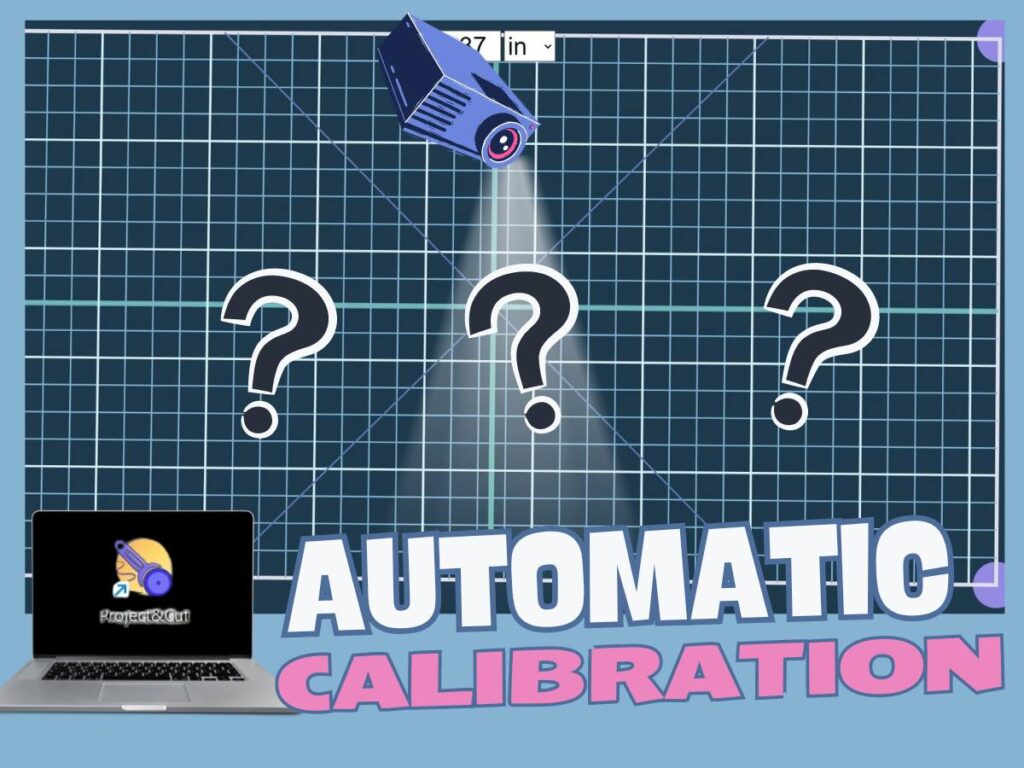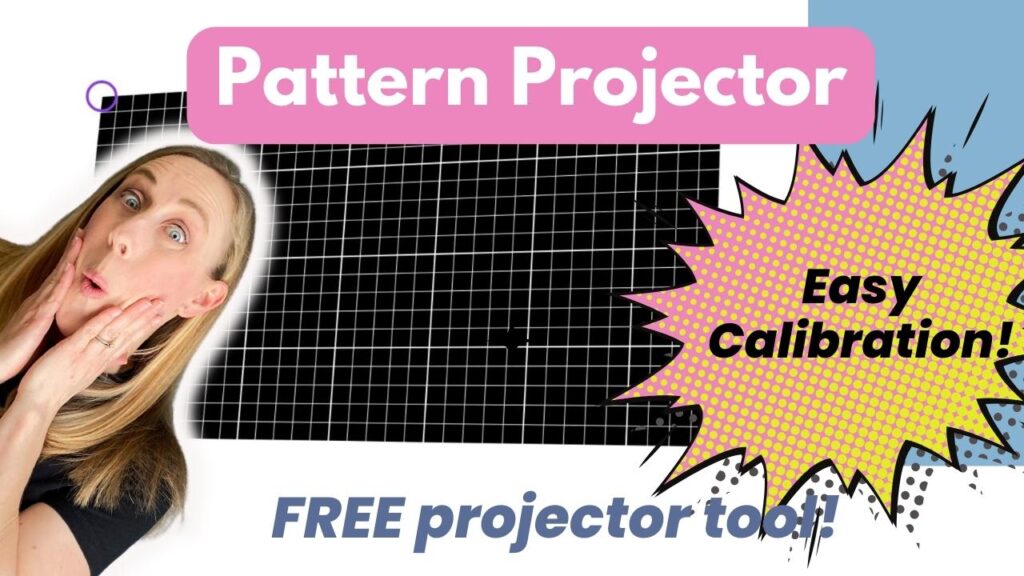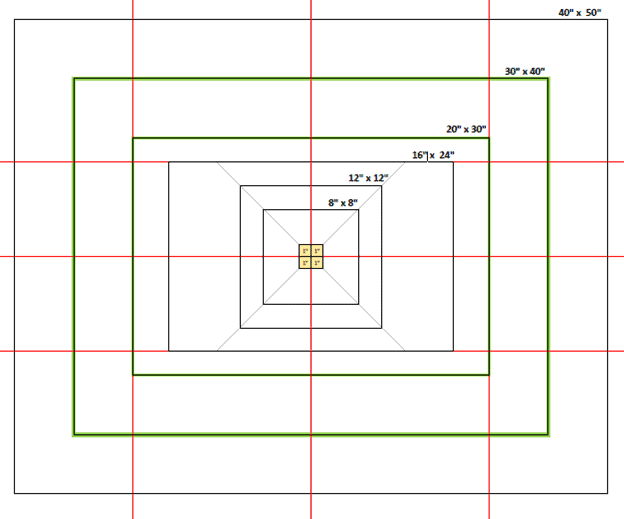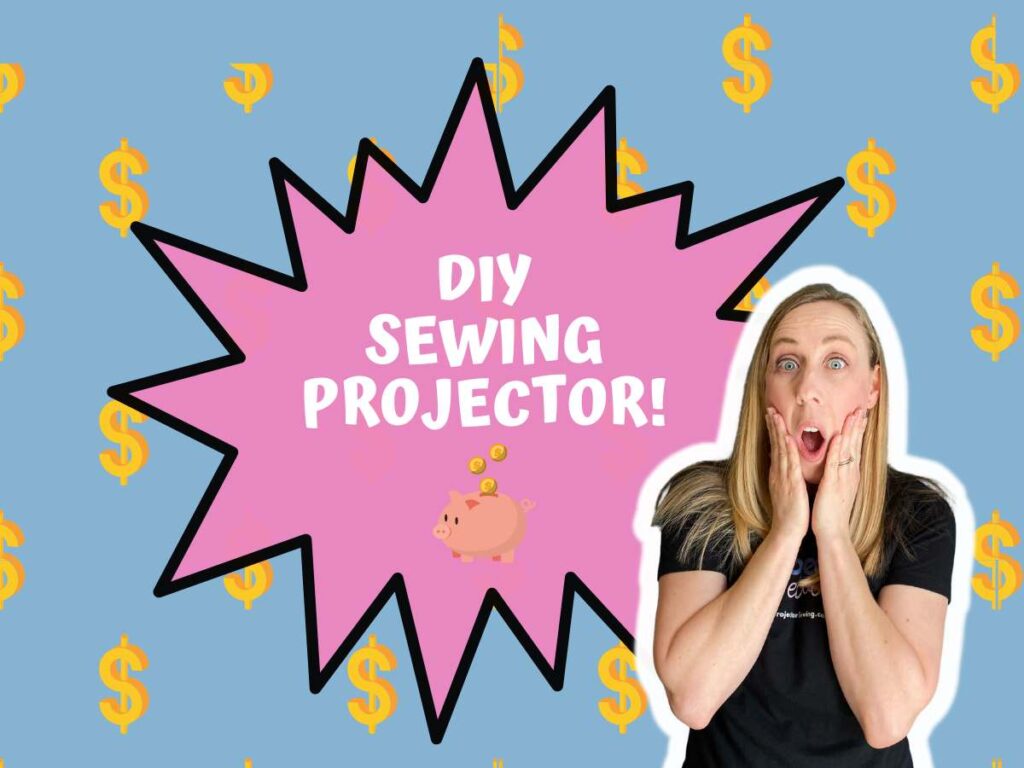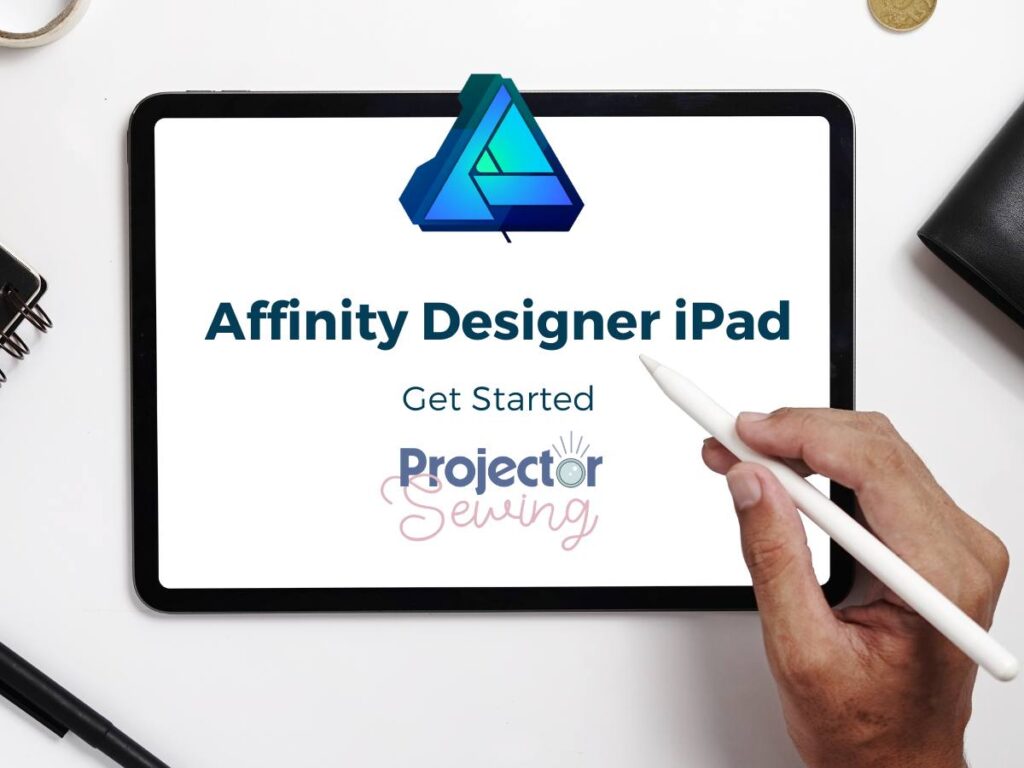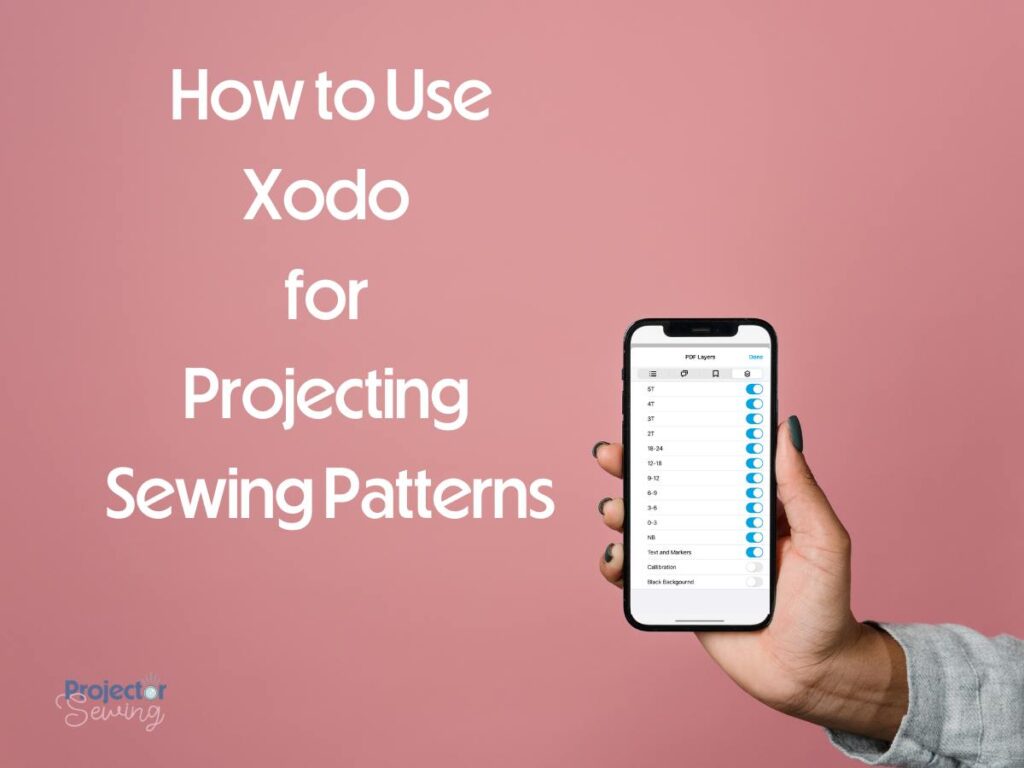Last updated on April 9th, 2024 at 01:28 pm
*This post may contain affiliate links and we may earn a small commission if you click on them.
Calibration. That is a scary word for many who are just joining the sewing with projectors world. It shouldn’t be! I will walk you through step-by-step how to calibrate a projector for sewing. You will get calibrated and back to sewing in no time!
I often hear people say, “I’m too nervous to get started!”. Just jump in and give it a try. If you follow the steps, you will get calibrated in no time.
For most people you will only need to calibrate your projector one time and that is it! Once you know how to calibrate a projector for sewing, it will be easier! Soon, you will be giving advice to others calibrating for the first time. If at any time you need help or advice, check out the active Projectors for Sewing Facebook group. I do not run the Facebook group, but it is an active community and members of the group are very helpful!
- What is Calibration?
- Prepare for Calibration
- Get Ready to Calibrate a Projector for Sewing
- Step-by-Step How to Calibrate a Sewing Projector
- Step 1: Setup Adobe
- Step 2: Mount/Setup Your Projector
- Step 3 : Squared Image
- Step 4 : Zoom in Adobe
- Step 5: Note Zoom % and Record Calibration
- Step 6: Ready to Cut!
- Conclusion
What is Calibration?
Calibration simply means that the image projected onto your cutting mat is “actual size”. In other words, the 1 inch (or 4cm) square on your pattern is actually that size in your projected image.
Calibration does not “change” your projector in anyway. It ensures that the image is level to the lens and cutting surface. When you are finished calibrating you will have a zoom percentage that you will use every time you open Adobe Reader DC. (If you are using different programs each time, you will need a zoom percentage for each program.) How you calibrate a sewing projector is done the same if you are using Xodo, Inkscape, or Affinity Designer.
Calibration is an essential step and your patterns will not cut out correctly without it. Don’t skip any steps! Skipping steps will add to your frustration.
Prepare for Calibration
Essential Programs
You will need a program that can read PDF files and access layers for pattern projection. No, you cannot use a USB drive and plug it into your projector expecting it to display your patterns. That’d be great if someone invented a sewing projector that did this!
What program is best for you depends on your end goal. For those on the computer and just starting out, I recommend Adobe Acrobat Reader DC. It is a free program for both Mac and PC users. I’ve written how to download and setup Adobe in this article.
Mobile and tablet users will need to use Xodo to project PDF files from a phone. Xodo is a free app that can be downloaded from the Apple or Google Play stores. I’ve gone over the important aspects of using a phone and tablet to project patterns here. Affinity Designer is another program that some tablet users enjoy using. It is not free, but gives more options.
Connect Your Device to Your Projector
HDMI
Connecting your computer, phone, or tablet via cable really is the best way to go. You will avoid many troubles that arise from wireless connections. However, there are many wireless connections listed below that work for pattern projecting when you are learning how to calibrate a projector for sewing.
HDMI is the best and most successful way to connect your device to your projector for sewing.
Most of the mini projectors will have an HDMI port. You will need to buy an extra long HDMI cord if your projector is mounted on the ceiling. Measure the distance from the ceiling to where your computer is. That is how long your cable will need to be. For most people, the 15ft cord works well. This is the one I use for my mini projector.
Troubleshooting Tip: Apemans may need the aspect ratio changed. Push the down arrow to access the aspect ratio. The Apeman LC350 needs to be set to “Panoramic” and the LC550 needs to be set to “Point-to-Point”.
HDMI on the Epson UST projectors have sometimes caused aspect ratio issues. If you are connect to HDMI with an UST and have aspect ration issues, then go to menu>Signal. Cycle through the aspect ration options to see if the issue is fixed. You may need to change the native resolution on your computer to 1024 x768 or 1280x 800. Go to System>Display to find the display and native resolution.
USB A /B
Some older Espon ultra short throw projectors can be connected using the USB A to B cable. The older models often do not have an HDMI port. If your projector has an HDMI port, then use that!
This is the same cable used to connect printers, Cricuts, and Silhouhette machines to computers. Look around the house and you may have an extra one. Or, you can buy them online for relatively cheap!

You may need to install a driver to your computer to use the USB B cable. Here are some links for downloading the needed drivers:
If you need specific information directly related to your Epson projector, you can type it in here: Epson® Official Support
VGA connections can work on the Epsons, but other projectors do not work well with the VGAs. You will need to use a VGA adaptor to connect to your computer.
*I do not recommend using VGA connections as this can cause distortion issues in your image and make calibrating your projector for sewing very difficult.
Screen Mirror
Screen mirror is an option available on iOS devices including: iPhones, iPads, and Mac computers. Screen mirror is a great option that is supported by many projectors, including the Vivimage Explore 2. Turn on the projector and look for a “screen mirror” option for sources. Select the “screen mirror” option, then return to your device.
On a Mac look for “Air Play”. If your projector is on and screen mirror is selected, it should be discoverable by “air play”. Select the projector from the Air Play list and it should connect.
Troubleshooting Tip: If your Mac doesn’t connect, you may need to check your Security and Privacy options. Go to your System Settings menu and scroll down to Screen Recording. Click ON for your projector. You may need to do this for Chromecast as well.
Screen mirror can be found on the iPhone by swiping down from the top right corner to reveal the control panel screen. Select the button with the two rectangles on top of each other. This will open the available screens to mirror to. The projector may be named something odd. If nothing else is available, that is probably it. Click it and it should connect. When it is connected a check mark should appear. You can now navigate on your phone and it will show on the screen.
Troubleshooting Tip: Bomaker projectors create their own WiFi signal. In order to connect to the Bomaker signal, you cannot be connected to your home WiFi. You often need to change the computer display resolution for the Bomaker to 1280 x 720.
Miracast
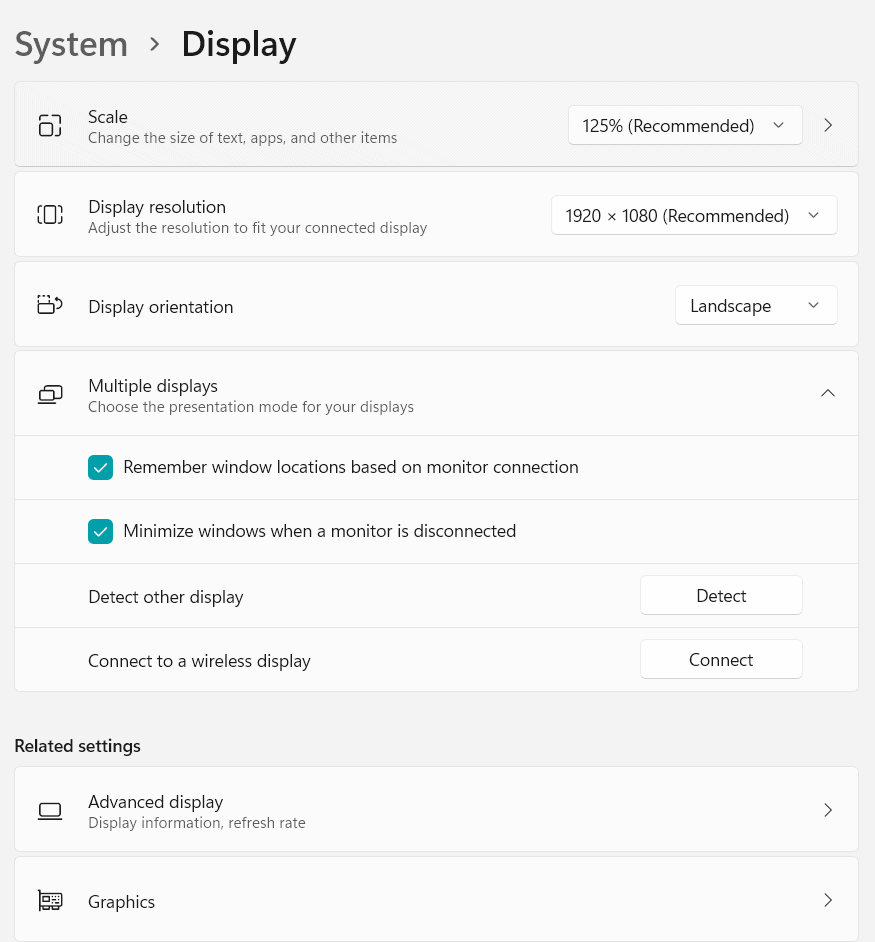 Miracast is aimed to be cross-platform and work like a wireless HDMI cable. Miracast works on devices running Windows 8.1 or later. Most Android phones and tablets are Miracast capable. Miracast can also work on computers. Miracast does not work with Chromebooks or Google Pixel devices.
Miracast is aimed to be cross-platform and work like a wireless HDMI cable. Miracast works on devices running Windows 8.1 or later. Most Android phones and tablets are Miracast capable. Miracast can also work on computers. Miracast does not work with Chromebooks or Google Pixel devices.
Miracast can be used to project phone, tablet, or computer screens to a projector. This is not used to project a laptop or computer to the projector. It is in fact screen mirroring for Android devices. Miracast can often have connection issues. So, if you are using Miracast and getting issues with your connection, it’s probably not the internet. It is most likely just that Miracast can be unstable. Try connecting a different way to see if the issue is solved.
To use Miracast on an enabled device, select “wireless display” in the settings menu. Select the Miracast screen you want to project to and follow the on screen directions.
Under the “Display resolution” choose a display resolution that matches your projector. Display resolution of your projector can be found in the Menu under System Information.
Sometimes Miracast connections will create a smaller image on the projector. This is true with the Vivimage Explore 2 projector.
Chromecast
Chromecast can turn any device into a wireless display. This means that you can connect your computer or laptop to a Chromecast device and wirelessly project to your projector.
This is a great option for projectors that are not Wi-Fi enabled. This will turn any HDMI (other adapters can be purchased) into a wireless display receiver. To see how to set up a Chromecast, watch the video below.
Get Ready to Calibrate a Projector for Sewing
Flat Surface
Having a flat surface will make your calibration process so much smoother! Whether you are cutting on a table or floor, you need it to be even all the way across your cutting mat. I do not recommend cutting on a folding table with a seam down the middle. Uneven surfaces, such as tile, can create complications. Add a piece of drywall, wood, sheet metal, or MDF under your cutting mat to make it even if necessary. Uneven surfaces will create image distortion and throw your cutting lines off.
Troubleshooting Tip: Add a piece of drywall, wood, sheet metal, or MDF under your cutting mat to make the surface even! Remember to always use the same setup when you are projecting patterns.
Tape Measure
Grab a tape measure to have on hand! A tape measure will make it easy to check the measurements of lines and boxes as you calibrate. Measuring the diagonal lines gives you a quick measurement to check!
Calibration Grid Mat
In order to calibrate using the calibration tool (below), you will need a mat to calibrate against. Most of us already have a cutting mat with a grid on it. You need a large grid to calibrate against for best results. I recommend a cutting mat at least A1 size or 36 inches x 24 inches. Large mats that are A0 sized are great for ultra short throw and short throw projectors that will create larger image sizes. This is the one I have and it works great! If you don’t have one yet, I highly recommend getting one before continuing on.

Calibration Tool
You will need a calibration tool file to help you correctly calibrate your sewing projector. If you don’t already have one, download the free calibration document linked below. This was created by Sasha Sewist, one of the Admins of the Projectors for Sewing Facebook group. There are two documents: Imperial (inches) and Metric (centimeters). Download the units that your cutting mat will match. Save it to your computer.
Download and open the calibration tool on your computer, tablet, or phone using Adobe Reader DC (free, computer), Affinity Designer (paid, mobile), Xodo (free, mobile), or Adobe illustrator (Paid, computer). Do NOT open and calibration from your internet browser (i.e. Chrome). If you are using a phone or tablet you will need to download a PDF reader such as Xodo.
Step-by-Step How to Calibrate a Sewing Projector
Step 1: Setup Adobe
Simple adjustments in Adobe will allow you to take advantage of full screen mode. Before going to full screen mode, go to Edit < Preferences (Windows) or Adobe Menu > Preferences (Mac). Click on Full Screen and turn off “Fill one page at a time”.
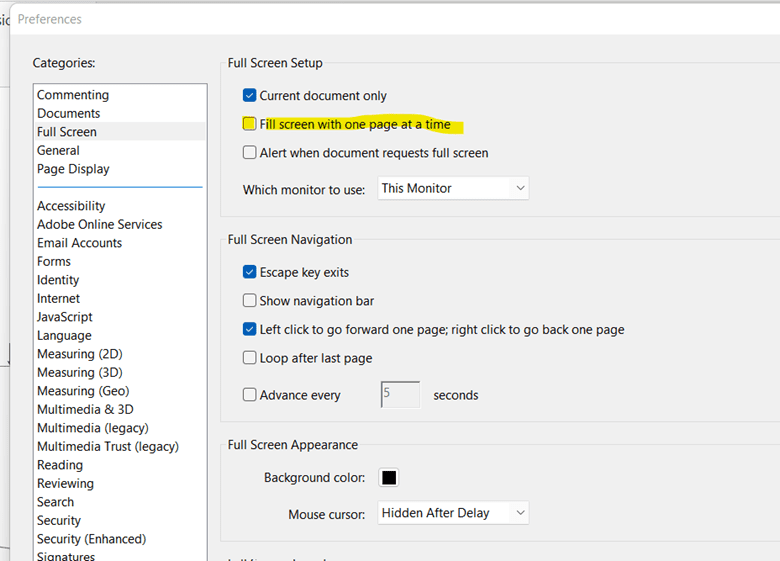
Now you can go between Full Screen mode by pressing Control L or Command L. Your zoom percentage will not change when you go to full screen mode. Use Control Y (Windows) or Command Y (Mac) to type in zoom when you are in full screen.
*Note that the entire calibration document will most likely not fit in your projection area. Find the center of the document and center it on your cutting grid.
Step 2: Mount/Setup Your Projector
In order to calibrate your projector, you will want it to be setup where it will be when you are sewing. It is best if this can be a permanent place, but you can also use a portable setup if needed to.
Mini Projectors
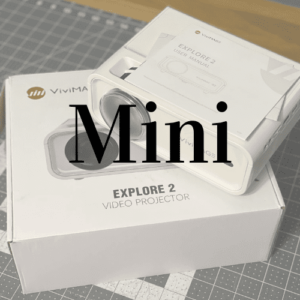
There are many ways that you can mount a mini projector. A mini projector must be above your cutting surface. Always check your projector image for offset before permanently mounting. Do this by turning on your projector and holding it where you plan to mount. Note that the image is generally where you like it and the size is suitable for you. We cannot change the size or location of the image during calibration.
Ultra Short Throw
Ultra short throws are generally placed on or up to 18 inches off the table. UST (Ultra Short Throw) projectors do have some offset. This means they will not project straight down by their base. The projection will generally be out about 6 -12 inches but varies by projector. Be sure to turn on the projector and see where the offset will lie on your cutting surface. This is the best time to make arrangements to your sewing room as needed! UST projectors can be put on the cutting table, on a shelf or ledge, mounted on the wall, or mounted on a portable TV stand.
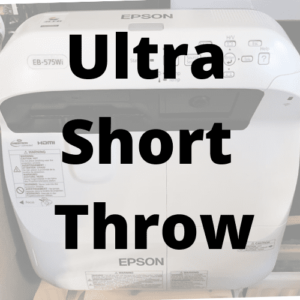
Short Throw
A short throw projector is a mix between an ultra short throw and mini projector. A short throw projector typically does need to be mounted. Some short throws have an “offset” or dead space between the lens and image. It varies from projector to projector. Some have zero offset, such as the Optoma ML1050ST, and are great for projecting on tables against the wall.
Turn it on to see how big the offset is from where you plan to mount it. Sometimes you may need to scoot the table away from the wall just a bit to take advantage of the full image. Short throws can also be clamped to a shelf. This is the best time to arrange your sewing room as needed!
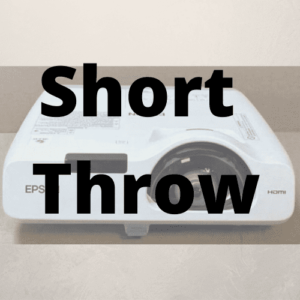
Step 3 : Squared Image
The goal of step 3 is to have a squared image. I suggest opening the calibration document and zooming in enough to see the corners and lines. You are going to make sure your projector is squared up to your cutting surface. Note that this doesn’t always mean your projector will be “level”. It will be level in accordance to your table.
Projector check
Locate the focus and keystone dials on your projector. Most of the time these are manual adjustments with levers around the lens. Sometimes these are adjusted using the projector settings and/or remote. Identify how to make keystone and focus adjustments on your projector before proceeding. Make sure manual keystones are in a neutral position. Are you using a secondhand projector? Reset the projector to factory settings! The reset can be found in the main menu.
If you notice a section on the menu that says “auto calibration” or “manual calibration”, these are not to “calibrate” the zoom for sewing! That is calibration of the screen for viewing (color, contrast, etc.). I recommend choosing manual calibration for the screen.
Physically Tilt and Level
Look at the projected image. You don’t want your image to be a trapezoid in any way. Tilt the projector left or right to see how the image changes. Tilt the projector forward and backwards. This will give you an idea of how to tilt will change the image.
Adjust the tilt of the projector so the right and left edges are parallel to each other. You just need the projector to line up with the cutting surface! If you think you have an uneven surface, you can use a level to check. “Dips” in the image are also an indicator of uneven surface.
Get out the tape measure and measure the sides. Are they the same length? If not, try tilting. Try to get within 99% accuracy. If it is as close as you can get move on!
If your top and bottom lines are not the same length, you will need to tilt the projector forward or backwards until they are. When they look parallel and even, check with a tape measure.
Often you will need to do both forward/backward and right/left tilts. Don’t be afraid to see how titling your projector these different ways change the image. This will help you to know how to best correct your image.
*Note: Many projectors, especially USTs, often only need minor adjustments. Mounts that use set screws are great for these adjustments. Other times just a folded up piece of cardstock will get the tilt you need.
Adjust Keystone and Focus
Adjustments to keystone and focus should be minor adjustments. If you need to do big adjustments, return to your projector setup and level and tilt the projector until you have square corners.
Even projectors that have “auto” focus and “auto” keystone may need to be manually adjusted. Manual adjustments are usually made using rings around the lens. Other times you can make these adjustments directly from your remote. Sometimes, you may need to go into your menu settings to make adjustments.
Keystone will adjust the image at an angle making it more rectangle or more trapezoid. If keystone adjustments and not making a square image, you may need to do more physical tilts and adjustments.
Now use the focus lever or dial on your projector to bring the calibration grid into clear focus. The lines and numbers should be clear enough to read. Make sure to open the document into Full Screen mode in Adobe.
Return to keystone and focus adjustments as needed throughout the calibration process.
Step 4 : Zoom in Adobe
Once you have a square image, then you can adjust the zoom on your computer in Adobe. You can use a PDF reader such as Xodo on mobile devices to adjust zoom using fingers.
Zoom can be adjusted in Adobe using Control Y (Windows) or Command Y (Macs). Then, you can adjust by typing in down to 0.1% zoom.
Align the projected calibration document to your cutting mat grid. Start by aligning the middle perpendicular lines in the center boxes. Next, adjust the zoom so that the inner 1 inch (or 2cm) squares match the squares on your mat. Center your image on the middle squares in the calibration document. Then move your mat to match the center of the image. The vertical and horizontal lines should line up with your mat.
Continue adjusting the zoom in Adobe in 0.1% increments, until the horizontal, vertical, and diagonal lines lineup on your cutting mat with the calibration document. Start with matching the smallest squares, then zoom to match the larger squares. As you match up the larger squares, the smaller squares will remain accurate. You want the largest rectangles in your image to be as accurate as possible! (Remember 99%) If you are off 1/8 on the largest rectangles, you are likely within the 99% accuracy.
Check the boxes on the calibration document with your tape measure to ensure accuracy.
Troubleshooting Tip: You may need to still make minor keystone/tilt adjustments so everything lines up.
Troubleshooting Tip: If your “squares” are “rectangles”, then you have an aspect ratio or display resolution issue. *Projectors with lower than 720p native resolutions do not work. Sometimes projectors with higher resolutions can have display issues.
Having Trouble Calibrating? Get Help
Not sure how your calibration is looking or want a second opinion? Head over to the Projectors for Sewing Facebook page and post a picture of your calibration. The members of the group are very helpful on giving tips, suggestions, or confirming that you are ready to cut! You may even see me over there!
Really stuck or ready to give up? Missy Pore, one of the Admins of the Facebook group offers one-on-one setup help for a small fee. Get Missy’s help HERE.
Step 5: Note Zoom % and Record Calibration
Once everything matches with 99% accuracy, you are calibrated! If your outer lines (largest boxes) are still 1/8 in off, you are within the accuracy needed! For a second opinion or for troubleshooting, post in the Projectors For Sewing Facebook group (no affiliated with this site).
Make note and record the calibration number. For example, my zoom is calibrated at 33.7% in Adobe.
Next time you open a projector pattern file or A0 file for sewing, zoom into your “calibrated zoom”. You cannot use this calibrated zoom on different programs. In other words, Adobe may have a different zoom percentage than Affinity Designer.
Step 6: Ready to Cut!
Jump for joy! Do a little dance! You did it!
You are now ready to cut your first pattern on your projector! I suggest starting with a pattern that has a dedicated projector file. Here are 17 free sewing patterns with projector files to get you started!
Now you are on your way to opening up a whole new world of sewing! Congratulations!
Now you can help a friend learn how to calibrate a sewing projector!
Become an expert in Adobe and pattern projecting: Intro to Adobe, Digital Annotations Part 1, and Digital Annotations Part 2: Height Adjustments
Conclusion
Whew! You did it! It is no small feat the first time you successfully calibrate a projector for sewing! It will get easier the more that you do it!
I suggested reading up on the tips and tricks in Adobe for projecting patterns starting with the Intro to Adobe post. Want to learn how to digitally “tape” PDF patterns together or make larger margins on your A0 or projector files? Then check out the tutorial on PDF stitcher!
Happy paper-free sewing!


